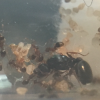So, I recently received a Formica sp. queen from Ants_Dakota, who was recently in the Black Hills. He first thought it to be a social parasite, yet to me she looks similar to pallidefulva. Just thought I'd get a second opinion:
1. Location of collection: near Custer State Park, Black Hills, South Dakota
2. Today's date: 6/9/20
1. Location of collection: near Custer State Park, Black Hills, South Dakota
2. Date of collection: irrelevant, collected under a rock out of nuptial flight season
3. Habitat of collection: forested area
4. Length: just barely short of 10 mm
5. Coloration, hue, pattern and texture: Shiny orange head and thorax, black wing scars, shiny black gaster
6. Distinguishing characteristics: Lots of pubescence near the back of gaster
7. Anything else distinctive: Was holding an egg in her mouth at one point
8. Nest description: N/A
9. Nuptial flight time and date: N/A
10.

















